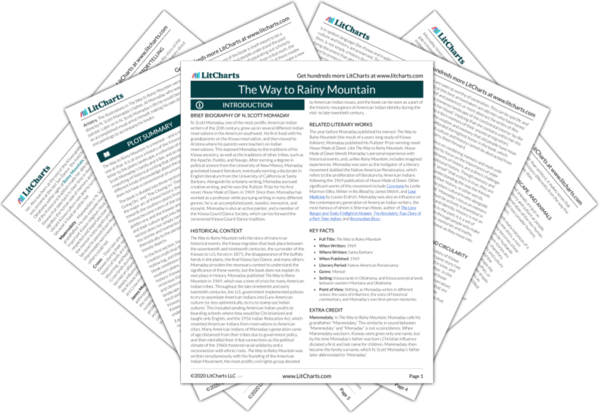Brief Biography of N. Scott Momaday
N. Scott Momaday, one of the most prolific American Indian writers of the 20th century, grew up on several different Indian reservations in the American southwest. He first lived with his grandparents on the Kiowa reservation, and then moved to Arizona where his parents were teachers on Indian reservations. This exposed Momaday to the traditions of his Kiowa ancestry, as well as the traditions of other tribes, such as the Apache, Pueblo, and Navajo. After earning a degree in political science from the University of New Mexico, Momaday gravitated toward literature, eventually earning a doctorate in English literature from the University of California at Santa Barbara. Alongside his scholarly writing, Momaday pursued creative writing, and he won the Pulitzer Prize for his first novel, House Made of Dawn, in 1969. Since then, Momaday has worked as a professor while pursuing writing in many different genres: he is an accomplished poet, novelist, memoirist, and essayist. Momaday is also an active painter, and a member of the Kiowa Gourd Dance Society, which carries forward the ceremonial Kiowa Gourd Dance tradition.
Historical Context of The Way to Rainy Mountain
The Way to Rainy Mountain tells the story of many true historical events: the Kiowa migration that took place between the seventeenth and nineteenth centuries, the surrender of the Kiowas to U.S. forces in 1875, the disappearance of the buffalo herds in the plains, the final Kiowa Sun Dance, and many others. Momaday provides the necessary context to understand the significance of these events, but the book does not explain its own place in history. Momaday published The Way to Rainy Mountain in 1969, which was a time of crisis for many American Indian tribes. Throughout the late nineteenth and early twentieth centuries, the U.S. government implemented policies to try to assimilate American Indians into Euro-American culture (or, less optimistically, to try to stamp out Indian culture). This included sending American Indian youths to boarding schools where they would be Christianized and taught only English, and the 1956 Indian Relocation Act, which resettled American Indians from reservations to American cities. Many American Indians of Momaday’s generation came of age distanced from their tribes due to government policy, and then rekindled their tribal connections as the political climate of the 1960s fostered racial solidarity and a reconnection with ethnic roots. The Way to Rainy Mountain was written simultaneously with the founding of the American Indian Movement, the most prolific civil rights group devoted to American Indian issues, and the book can be seen as a part of the historic resurgence of American Indian identity during the mid- to late-twentieth century.
Other Books Related to The Way to Rainy Mountain
The year before Momaday published his memoir
The Way to Rainy Mountain (the result of a years-long study of Kiowa folklore), Momaday published his Pulitzer Prize-winning novel
House Made of Dawn. Like
The Way to Rainy Mountain, House Made of Dawn blends Momaday’s personal experience with historical events, and, unlike
Rainy Mountain, includes imagined experiences. Momaday was seen as the instigator of a literary movement dubbed the Native American Renaissance, which refers to the proliferation of literature by American Indians following the 1969 publication of
House Made of Dawn. Other significant works of this movement include
Ceremony by Leslie Marmon Silko,
Winter in the Blood by James Welch, and
Love Medicine by Louise Erdrich. Momaday was also an influence on the contemporary generation of American Indian writers, the most famous of whom is Sherman Alexie, author of
The Lone Ranger and Tonto Fistfight in Heaven,
The Absolutely True Diary of a Part-Time Indian, and
Reservation Blues.
Key Facts about The Way to Rainy Mountain
-
Full Title: The Way to Rainy Mountain
-
When Written: 1969
-
Where Written: Santa Barbara
-
When Published: 1969
-
Literary Period: Native American Renaissance
-
Genre: Memoir
-
Setting: Kiowa lands in Oklahoma, and Kiowa ancestral lands between western Montana and Oklahoma
-
Point of View: Shifting, as Momaday writes in different voices: the voice of tribal lore, the voice of historical commentary, and Momaday’s own first-person memories
Extra Credit for The Way to Rainy Mountain













